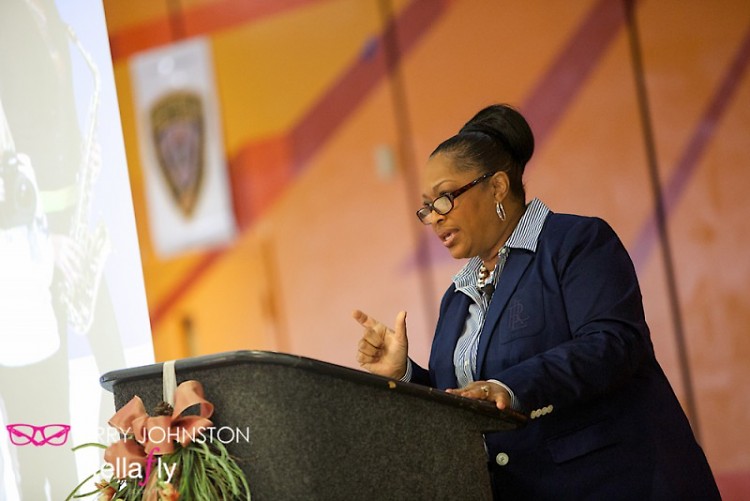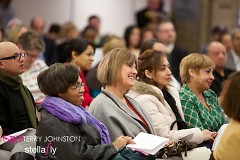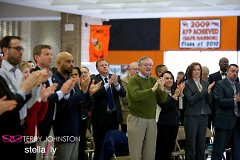On Saturday, May 16, from 9:00 a.m. to 10:00 a.m. at Ottawa Hills High School, Superintendent Teresa Weatherall Neal will be giving her 3rd annual State of Our Schools address. Doors open at 8:30 a.m. and light refreshments will be served. The event is free and open to the public. RSVPs are requested by calling 819-2193 or email [email protected].
This year, the State of Our School’s speech is expected to focus on the successful implementation of Phase I of the GRPS Transformation Plan while also touting Phase II planning. Particular emphasis will be on the bond proposal and how it is essential it is to future stability, growth and success of GRPS. The following is an overview of the GRPS Transformation success story and the story behind the proposed bond.
History in the Making
The GRPS security, technology and construction bond is a long time in the making. It is a result of extensive community engagement, long term planning, sound fiscal management and proven results. The proposal was first initiated by the community more than 10 years ago. In 2004, the Phase I Building Improvement Plan was developed as part of a six month process to address dilapidated school facilities and outdated technology.
In 2004, 60% of our community voted to approve a $165 million bond. The Phase I Building Improvement Plan was the guidebook for how that money was spent. Thanks to good planning, sound fiscal management and effective implementation, the projects came in on time and under budget, which allowed for the addition of two additional projects. Those projects were the reconstruction of Cesar E. Chavez Elementary and renovation of Houseman Field.
When Phase I was developed, the community also recommended that the district updated the Building Improvement Plan every five years as the list of needs and projects far exceeded $165 million. In 2008, GRPS went through another extensive community engagement process and developed the Phase II Building Improvement Plan. Due to the economic recession, the Board of Education decided the timing wasn’t right and did not pursue a bond.
Without a bond and desperately in need of new facilities, the Board of Education looked to other ways to address the needs of the district. GRPS constructed two new schools, UPrep and Blandford, without a single local or state taxpayer dollar. This is a first of its kind in the region and a model that gained GRPS state and national attention.
In 2011, GRPS asked voters to approve a five year Warm, Safe, and Dry millage as a stop-gap measure to address basic facility needs, such as roofs, boilers, windows, heating and cooling and pipes.
For more than 20 years, GRPS had been in a state of churn and decline. We lost more than 8,000 students, closed 35 schools, cut $100 million out of the budget, eliminated 1,000 jobs and had nuclear style negotiations.
In January 2012, Teresa Weatherall Neal was appointed superintendent and went on an aggressive listening tour with four basic questions.
- What is working?
- What isn’t?
- What are the barriers?
- And what are the solutions?
More than 1,000 individuals participated in small group meetings, large community meetings, surveys and more. Superintendent Neal used the results of the Listening Tour, Phase II Building Improvement Plan, Cambridge Report, Academic Plan and Five Year Strategic Plan to develop a bold, comprehensive plan aimed at restoring stability and growth to GRPS. The GRPS Transformation Plan received overwhelming support from the community and was unanimously approved by the Grand Rapids Board of Education in December 2012. Since then, it has been the driving force behind the energy, excitement, and momentum growing around GRPS!
Stability and Growth
The Transformation Plan has three guiding values. First, invest in what’s working. It is important to maintain, expand, replicate and create new schools, programs and services that are retaining and attracting students and parents and producing academic results. Second, we must invest in talent retention, recruitment and development. We know the key to student success is having the best teachers and school leaders. Finally, we must create a culture of stability and growth.
Phase I of the Transformation Plan called for expanding the number of K-8 schools; bringing the talent, innovation and resources of four Centers of Innovation scattered throughout the city to one building, Innovation Central High, where they could co-locate for maximum outcomes; reinvesting in theme schools; expanding the number of theme schools by opening Gerald R. Ford Academic Center; reopening Stocking elementary; partnering with neighborhoods and community organizations to pilot a cutting edge neighborhood-school reclamation project at Congress and Mulick Park; re-missioning and transforming central office to focus on customer service and supporting schools, instead of the old top down bureaucratic model; reducing the number of comprehensive high schools and varsity athletic teams from three to two; implementing school uniforms district wide and overhauling human resources to focus on talent retention, recruitment and professional development.
Phase I was successfully implemented in one school year. This is nothing short of remarkable and demonstrates the caliber and quality of the staff in the district. For the first time in two decades, stability is being restored, we are united as a district and operations are firing on all cylinders.
Following the successful implementation of Phase I, GRPS is embarking on Phase II of the Transformation Plan. Phase II includes opening and expanding several schools. CA Frost Environmental Science Academy is currently a successful kindergarten through 8th grade environmental education program. The Transformation Plan calls for CA Frost to be expanded to a preschool-12th grade program. Beginning in the fall of 2015, CA Frost will serve students in preschool through 9th grade. An additional grade will be added each school year. The expansion requires more classroom space than the current facility has, so Covell will be reopened in the fall of 2016, and the wooded area, stream, park land and trail system nearby will be used. Another planned expansion is for Zoo School. Zoo School is currently a 6th grade program but will have room to expand to 6-8th grade under the John Ball Zoo Master Plan. Additionally, plans are in development to expand Southwest Community Campus, a dual immersion school. It is currently a kindergarten through 8th grade program, but will become a preschool through 12th grade program under Phase II.
In the fall of 2015, a brand new school will be opening. The Grand Rapids Public Museum School will start with 6th grade only and grow one grade per year to become 6th-12th. Students will actually attend school at the Public Museum and experience a cutting edge, place based curriculum with an emphasis on using the design thinking process to learn creative problem solving skills. This Center of Innovation is made possible thanks to a partnership with the Grand Rapids Public Museum, Grand Valley State University, Kendall College of Art and Design, the City of Grand Rapids, Downtown Grand Rapids, Inc. and the Downtown Development Authority. Phase II also calls for an International Baccalaureate arts academy. In partnership with the Grand Rapids Symphony, GVSU, Kendall College of Art and Design and other arts organizations, Coit Creative Arts Academy will be transformed into the International Baccalaureate (IB) program. IB is recognized worldwide and is a proven educational model.
Additionally, Phase II calls for the transformation of the Central Campus. Currently home to Grand Rapids Montessori and Innovation Central, the Central Campus has been included in the downtown master plan in partnership with Downtown Grand Rapids, Inc. Highlights of the plan include demolition of the old City building, making historic renovations and improvements to the facilities, exploring an urban farm concept that would introduce the Erdkinder Montessori model and allow Innovation Central students to enjoy hands-on learning, improving traffic flow and parking and landscaping and beautifying the property. Finally, Phase II calls for continued central office reforms and talent retention and recruitment efforts.
Success
In a short amount of time, the Transformation Plan has shown significant results. Graduation rates have increased for three consecutive years, including double digit increases for African American and Hispanic/Latino students. Test scores are trending up across the district. Chronic absenteeism has dropped 25%. Staff morale is up. And GRPS is one of the few urban districts in the state that saw its bond rating not only increase from negative to stable but also remain stable for four years.
As a result of the Transformation Plan, the district had the best fall and spring count days in two decades. In the fall of 2014, GRPS was projected to lose 400 students but lost less than 30. On the spring 2015 count day, we actually gained students! This is practically unheard of in an urban public school and is evidence that stability is being restored to the district. GRPS is now poised to be one of the first urban districts in the state and nation to grow enrollment.
The Transformation Plan has earned GRPS much praise and recognition. Recently, WalletHub put GRPS at the top of its list of efficient spenders in education. Superintendent Neal was named regional superintendent of the year and has been called on to present about the Transformation Plan at the state level.
Secure, Connect, Transform
The proposed GRPS bond is about more than buildings. The future growth and success of GRPS is not just an education issue or a city issue, it’s a regional issue. It’s about economic development, workforce development and quality of life. It’s about retaining and attracting families, job providers and talent. It’s about investing to make Grand Rapids the number one mid-sized city in America. GRPS is poised to become a national model for how large urban public school districts can transform for stability, growth and academic success. Passage of the bond is absolutely key to ensure we keep the momentum and success going.
Version 1.0 of the bond plan was created based upon the work of the 2008 Building Improvement Plan Phase II steering committee, the Transformation Plan and input from district leaders. Students, parents, staff and the community are encouraged to share their feedback about this list. Just like the Transformation Plan was open for public comment and morphed from version 1.0 to version 3.0 before being adopted, the list of proposed bond projects will undergo a similar process. If the bond passes, GRPS plans to invest in every school in the district through technology, security or construction.
The average home in Grand Rapids is valued at $100,000. A homeowner with a home at that value would pay just $8.33 per month or $99.96 per year. That’s no more than the cost of a monthly Brann’s Sizzler!
There are a series of community meetings taking place throughout the city where parents, students, staff and community have an opportunity to share their feedback about the proposed bond projects. Rapidian readers are urged to please mark your calendar to attend one of these meetings and share your input. Also, please be sure to mark your calendar for Election Day, which is November 3.
The Rapidian, a program of the 501(c)3 nonprofit Community Media Center, relies on the community’s support to help cover the cost of training reporters and publishing content.
We need your help.
If each of our readers and content creators who values this community platform help support its creation and maintenance, The Rapidian can continue to educate and facilitate a conversation around issues for years to come.
Please support The Rapidian and make a contribution today.



